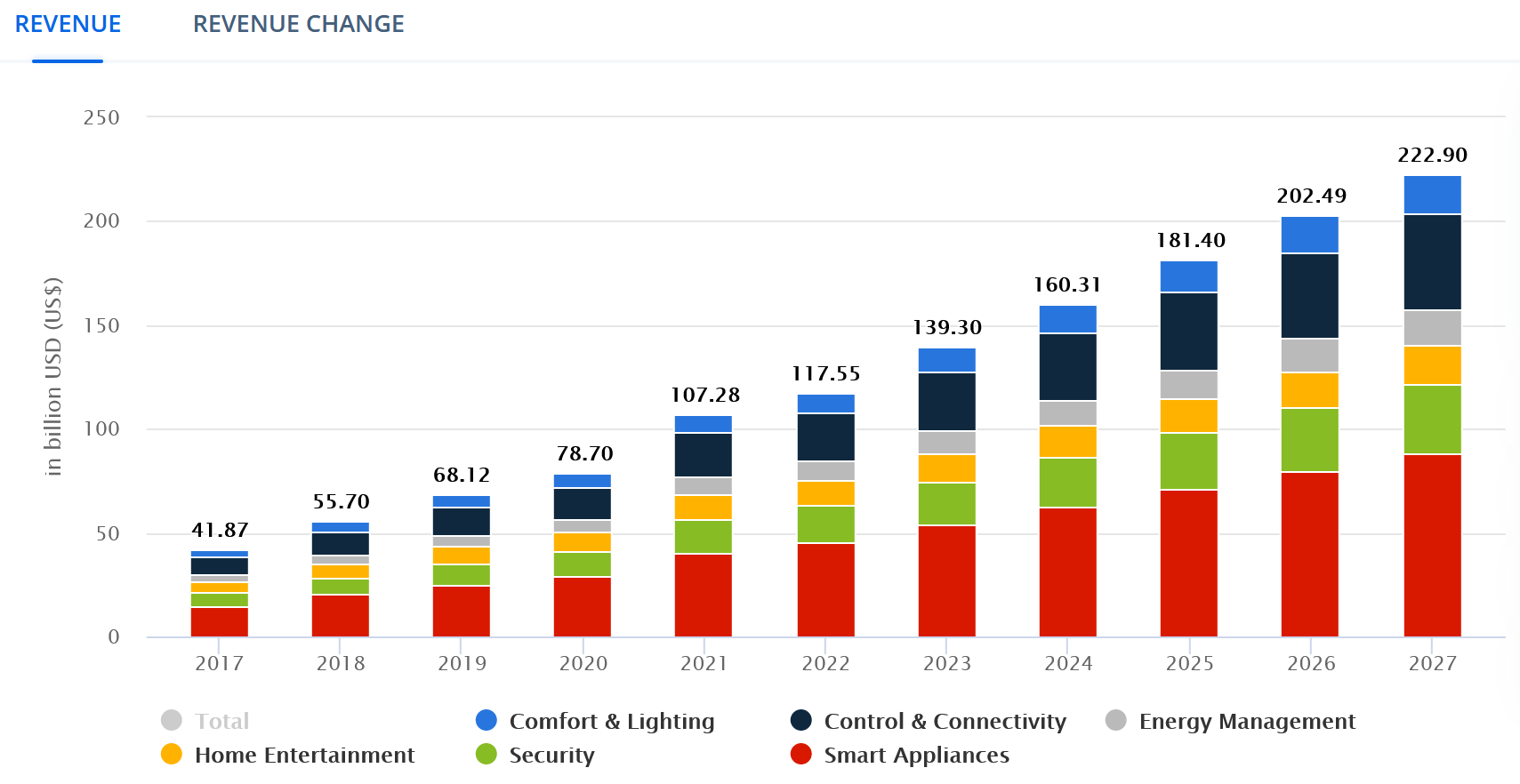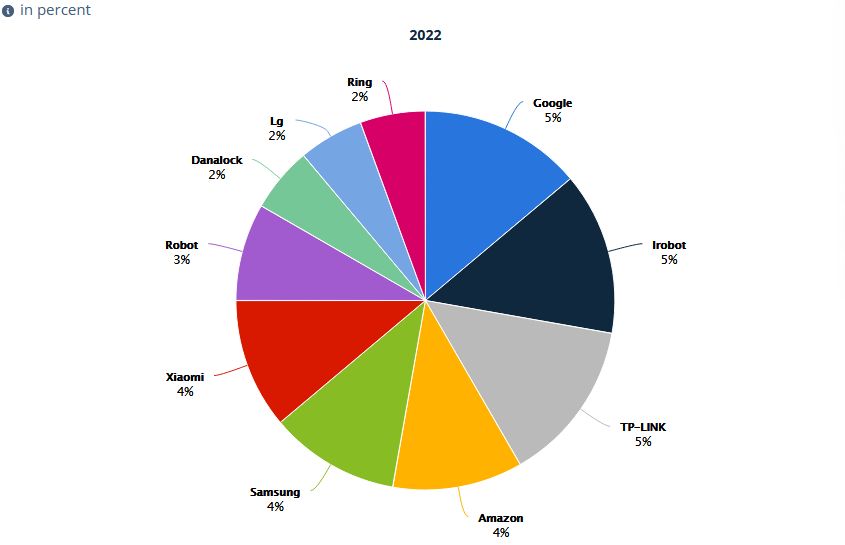The Internet of Things (IoT) continues to revolutionize the way we interact with technology, connecting devices and enabling seamless communication. As we move into the second half of 2023, it's essential to reflect on the significant events and developments that have unfolded in the IoT market thus far. This article will provide a synopsis of the first half of the year and explore the anticipated trends and advancements expected to shape the IoT market in the coming months.
Before we dive into the summary, let us give you some numbers to outline why the IoT landscape is a field you should definitely not underestimate. The chart below illustrates a forecast fr the Smart Home Sector as of 2022. Statista Market Insights is confident about the market volume increasing up to more than 222 billion US Dollars.

IoT market volume by Statista Market Insights
Now as to who will profit from this development - this chart shows the top brands in the market according to an update this February. Please note that only the top brands are shown here, since there is a large number of providers in this field.

IoT brand share by Statista Market Insights
Synopsis of the First Half
Rapid Expansion of IoT Applications: The first half of 2023 witnessed a rapid expansion of IoT applications across various sectors. Industries such as healthcare, manufacturing, agriculture, and transportation leveraged IoT technology to improve operational efficiency, automate processes, and enhance decision-making. From remote patient monitoring in healthcare to predictive maintenance in manufacturing, IoT solutions showcased their transformative potential.
Continued Focus on Data Privacy and Regulation: Data privacy and security remained at the forefront of discussions surrounding IoT in the first half of the year. With increasing concerns about data breaches and the misuse of personal information, regulatory bodies and organizations emphasized the importance of robust data protection measures. Efforts were made to develop and implement stringent regulations to ensure the responsible and ethical use of IoT data.
With the increasing number of interconnected devices, organizations must prioritize data privacy to build trust with their customers and comply with regulations. Investing in robust consent management mechanisms becomes essential to ensure that individuals have control over their data and give explicit consent for its usage. Consent management platforms allow users to understand and manage the data being collected, specify their privacy preferences, and provide informed consent for data processing. By implementing strong consent management practices, organizations can foster transparency, establish a sense of accountability, and demonstrate their commitment to protecting user privacy in the evolving IoT ecosystem.Advancements in Edge Computing: Edge computing gained significant traction in the first half of 2023. Organizations recognized the benefits of processing and analyzing data at the edge of the network, closer to where it is generated. Edge computing helped reduce latency, improve response times, and alleviate bandwidth constraints. The integration of edge computing with IoT systems opened new opportunities for real-time analytics and intelligent decision-making.
Accelerated Deployment of 5G Networks: The first half of 2023 witnessed an accelerated deployment of 5G networks, laying the foundation for enhanced IoT connectivity. 5G networks offer higher bandwidth, lower latency, and improved reliability, addressing the limitations of previous generations of cellular networks. This technology will enable the seamless communication of a vast number of IoT devices, supporting use cases that demand ultra-low latency and high data throughput.
Growing Adoption of AI and Machine Learning: Artificial intelligence (AI) and machine learning (ML) made significant contributions to the IoT landscape in the first half of the year. These technologies played a vital role in enabling intelligent automation, predictive analytics, and anomaly detection in IoT systems. AI-powered IoT platforms and solutions gained traction, allowing organizations to extract valuable insights from massive amounts of data collected by connected devices.
What's to come?
The overview shows that the market is growing and expanding in many directions at the same time. These developments give us reason to believe that we will see the following trends in the second half of the year.
Edge Computing Dominance: One of the key trends that will gain momentum in the latter half of this year is the dominance of edge computing in IoT systems. With the exponential growth of connected devices and the need for real-time data analysis, edge computing allows for faster processing, reduced latency, and enhanced privacy. Expect to see increased adoption of edge computing platforms and solutions, enabling IoT devices to process and analyze data at the edge of the network.
Enhanced Security Measures: As IoT devices continue to proliferate, ensuring robust security measures becomes paramount. The second half of 2023 is expected to witness significant advancements in IoT security protocols. Industry leaders and technology experts are investing in developing improved encryption, authentication, and access control mechanisms to protect IoT ecosystems from potential vulnerabilities and cyber threats. Look out for innovative security solutions that provide end-to-end protection for IoT networks and connected devices.
5G Expansion: The deployment and expansion of 5G networks are poised to have a profound impact on the IoT market. The second half of 2023 will witness further rollouts of 5G infrastructure, enabling faster and more reliable connectivity for IoT devices. The high-speed, low-latency capabilities of 5G will unlock new possibilities for IoT applications in sectors such as healthcare, manufacturing, transportation, and smart cities. Keep an eye on the integration of 5G with IoT, leading to enhanced productivity and efficiency across various industries.
AI and Machine Learning Integration: Artificial intelligence (AI) and machine learning (ML) are increasingly becoming integral components of IoT systems. In the latter half of 2023, we can expect further advancements in AI and ML algorithms tailored specifically for IoT applications. These technologies will enable devices to process vast amounts of data, extract valuable insights, and make autonomous decisions, leading to improved efficiency and intelligent automation. Watch out for IoT platforms and solutions that seamlessly integrate AI and ML capabilities
Continued Growth of Smart Home Technology: The adoption of smart home technology will continue to grow steadily throughout the second half of 2023. With increasing consumer demand for connected and automated homes, expect to see innovative IoT devices and ecosystems designed specifically for the residential sector. Enhanced voice assistants, smart appliances, energy management systems, and home security solutions will dominate the market as consumers embrace the convenience and efficiency offered by smart home technology.
The IoT market is evolving rapidly, and the second half of 2023 promises to be an exciting period for the industry. From the proliferation of edge computing and improved security and data privacy measures to the expansion of 5G networks and the integration of AI and ML, these trends and developments will shape the future of IoT.
Contact
Partner & Sales Manager: Alexander Jürgens
E-Mail: office@apocrat.at
Mobile: +43 676 4025255

